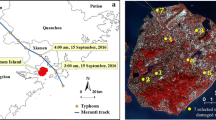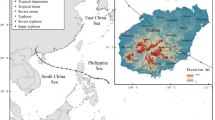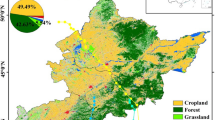Abstract
Developing nations are abandoned against tropical cyclones because of climatic changeability; the atmosphere is probably going to expand the recurrence and extent of some outrageous climate and calamity occasions. Urban areas and towns arranged along the coastline front belt in Visakhapatnam region experienced serious harm because of Hudhud cyclone, which happened on October 12, 2014. The fundamental motivation behind this exploration was to distinguish the vegetation damage in Visakhapatnam and neighbouring towns. In this analysis, Landsat-8 satellite datasets procured prior and then afterward the cyclone have been utilized; image processing techniques have been completed to evaluate the progressions of pre- and post-disaster condition. Vegetation index strategy was utilized to assess the damage to vegetation. Arrangement results and land utilize land cover change investigation demonstrate that 13.25% of agriculture Kharif and 31.1% of vegetation was damaged. Normalized difference vegetation index (NDVI) maps were produced for the previously, then after the cyclone circumstance, and vegetation biomass damage was evaluated in Visakhapatnam and Bhimunipatanam. General loss of vegetation in both the spots was 30.67 and 43.37 km2. The result of this review can be utilized by decision makers for the post-disaster support for rebuilding of influenced regions.







Similar content being viewed by others
Change history
03 February 2018
The original version of this article, unfortunately, contained errors. Fig. 1 has some issue that India as shows without complete boundary. Given in this article is the correct image.
References
Asrar G, Fuchs M, Kanemasu ET, Hatfield JL (1984) Estimating absorbed photosynthetic radiation and leaf area index from spectral reflectance in wheat. Agron J 76(2):300–306. https://doi.org/10.2134/agronj1984.00021962007600020029x
Atkinson PM, Lewis P (2000) Geo-statistical classification for remote sensing: an introduction. Comput Geosci 26(4):361–371. https://doi.org/10.1016/S0098-3004(99)00117-X
Bausch C, Walter (1993) Soil background effects on reflectance-based crop coefficients for corn. Remote Sens Environ 46:213–222
Benefetti R, Paolo R (1993) On the use of NDVI profiles as a tool for agricultural statistics: the case study of wheat yield estimates and forecast in Emilia Romagna. Remote Sens Environ 45(3):311–326. https://doi.org/10.1016/0034-4257(93)90113-C
Bhowmik A, Cabral P (2011) Damage and posyt-cyclone regeneration assessment of the sundarbans botanic biodiversity caused by the cyclone sidr. 1st world sustainability forum
Deering DW, Haas RH (1980) Using Landsat digital data for estimating green biomass. NASA Technical Memorandum, Greenbelt, p 2
Disaster Management of India: A status Report, Natural Disaster Management Division, Ministry of Home Affairs, Government of India, New Delhi (2004) http://saarcsdmc.nic.in/pdf/publications/journal/chapter-9.pdf . Accessed on 24 Jan 2015
Douglas I (1999) Hydrological investigations of forest disturbance and land cover impacts in South-East Asia: a review. Philos Trans R Soc Lond Series B 354(1391):1725–1738. https://doi.org/10.1098/rstb.1999.0516
HUDHUD Damage Assessment & Relief Monitoring System Government of Andhra Pradesh (2014) http://hudhud.ap.gov.in/HDRMS/UserInterface/Loginform.aspx, Accessed on 25 Jan 2015
Jensen JR (2004) Introductory digital image processing, 3rd edn. Pearson Prentice Hall, Upper Saddle River, p 544
Kaufmann RK, Zhou L-M, Myneni RB, Tucker CJ, Slayback D, Shabanov NV, Pinzon J (2003) The effect of vegetation on surface temperature: a statistical analysis of NDVI and climate data. Geophys Res Lett 30:21–47
Nisha R, Mandla VR, Singh T (2016) Evaluation of atmospheric corrections on hyperspectral data with special reference to mineral mapping. Geosci Front 8(4):797–808. https://doi.org/10.1016/j.gsf.2016.06.004
Penner JE (1994) Atmospheric chemistry and air quality. In: Meyer WB, Turner BL II (eds) Changes in land use and land cover: a global perspective. Cambridge University Press, Cambridge, pp 175–209
Revenue Disaster Management Department, Govt of Andhra Pradesh (2005), disaster management.ap.gov.in, Accessed on 20 Dec 2014
Richardson AJ, Wiegand CL (1977) Distinguishing vegetation from soil background information. Photogramm Eng 43:1541–1552
Rogan J, Chen D (2004) Remote sensing technology for mapping and monitoring land cover and land-use change. Prog Plan 61(4):301–325. https://doi.org/10.1016/S0305-9006(03)00066-7
Skole DL (1994) Data on global land-cover change: acquisition, assessment and analysis. In: Meyer WB, Turner BL II (eds) Changes in land use and land cover: a global perspective. Cambridge University Press, Cambridge, pp 437–471
Tarun T, Mandla VR, Srinivas T, Mahendra (2013) Evaluation of various image classification techniques on Landsat for identifies coral reefs, Geomatics. Nat Haz Risk 5(2):173–184
Tucker CJ (1979) Red and photographic infrared linear combinations for monitoring vegetation. Remote Sens Environ 8(2):127–150. https://doi.org/10.1016/0034-4257(79)90013-0
Vani V, Mandla VR (2017) Comparative study of NDVI and SAVI vegetation indices in Anantapur district semi-arid areas. Int J Civil Eng Technol l8(4):559–566
Vitousek PM (1994) Beyond global warming: ecology and global change. Ecology 75(7):1861–1876. https://doi.org/10.2307/1941591
Wanjura DF, Hatfield JL (1987) Sensitivity of spectral vegetation indices to crop. Biomass 30:810–816
Wu W, Shao G (2002) Optimal combinations of data, classifiers, and sampling methods for accurate characterization of deforestation. Can J Remote Sens 28(4):601–609. https://doi.org/10.5589/m02-050
Acknowledgments
Authors would like to thank editor and anonymous reviews for their valuable suggestion and also would like to thank Dr. Colil Arrowsmith, A/Professor, RMIT, Australia, for his suggestions on manuscript and proof reading.
Author information
Authors and Affiliations
Corresponding author
Rights and permissions
About this article
Cite this article
Konda, V.G.R.K., Chejarla, V.R., Mandla, V.R. et al. Vegetation damage assessment due to Hudhud cyclone based on NDVI using Landsat-8 satellite imagery. Arab J Geosci 11, 35 (2018). https://doi.org/10.1007/s12517-017-3371-8
Received:
Accepted:
Published:
DOI: https://doi.org/10.1007/s12517-017-3371-8




